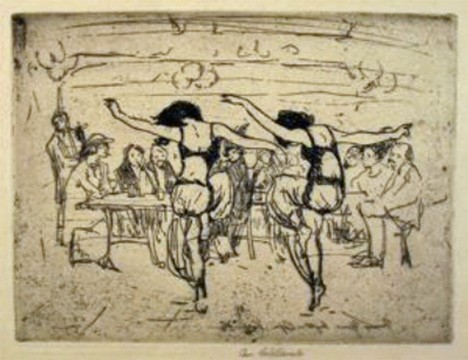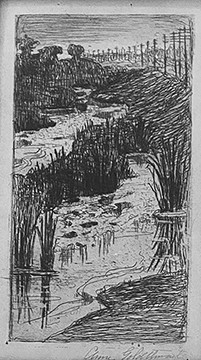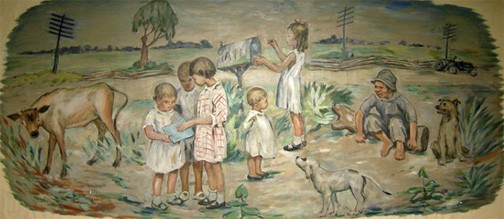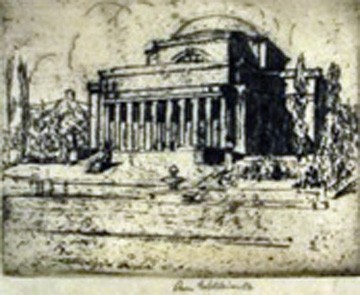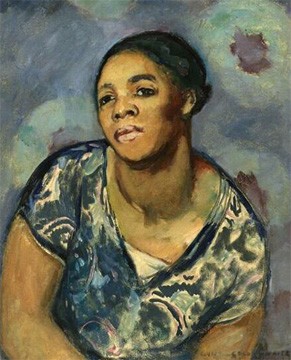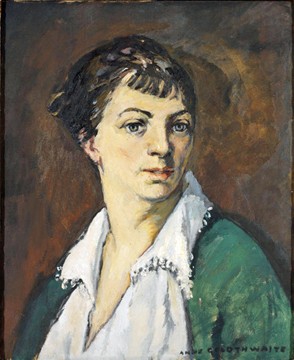Anne Wilson Goldthwaite, 1869 – 1944
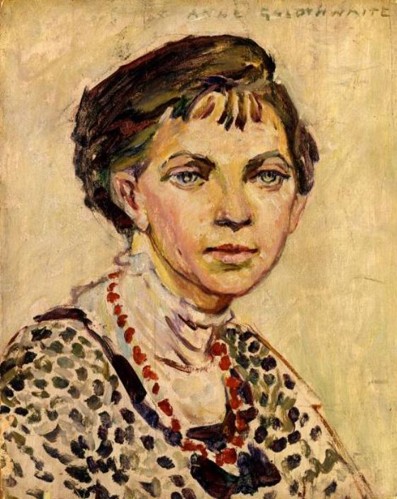
Anne Wilson Goldthwaite is known as a prominent painter, printmaker, and advocate for women's rights. A true daughter of the South (her father had served in the Confederate army), Goldthwaite was born in Montgomery, Alabama in 1869 and grew up in Dallas, Texas. She was the oldest of four siblings – they were orphaned when she was just twelve years old and raised by relatives (Davis and Emerson 22). Thanks to the financial support of an uncle who was impressed with Anne’s painting and drawing skills, she moved to New York to study art. Goldthwaite trained at the National Academy of Design from 1903 – 1906, studying painting with Francis Coates Jones and etching with Charles Frederick Mielatz (Ausfeld). Another of her early teachers was Walter Shirlaw, a Scottish-American painter and illustrator. Goldthwaite spent a summer in this period in Princeton, New Jersey, where she met then-professor Woodrow Wilson and painted a commissioned portrait of his wife.
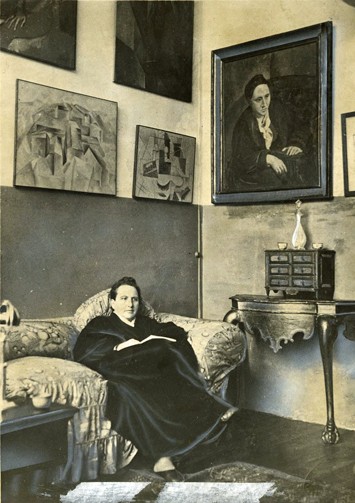
Like many young art students in the early 20th century, Goldthwaite was drawn to Paris, where she explored Modernist styles like Fauvism and Cubism. Though she did receive some criticism from atelier master Charles Guérin, Goldthwaite mostly worked independently with a group called the Académie Moderne, informally headquartered at 86 rue Notre-Dame-des-Champs. This group would leave Paris each summer and travel together to places like Ile aux Moines, Cassis en Midi, or Fontenay-aux-Roses to work en plein air in the countryside (Birnbaum 6).
Legend has it that Goldthwaite met Gertrude Stein while sketching in Luxembourg Gardens and it was through Stein that she encountered avant-garde artists like Cezanne, Matisse, and Picasso. In her memoirs, preserved in the Smithsonian's Archives of American Art, Goldthwaite recalls Stein as "'a large, dark woman...who looked something like an immense brown egg. She wore, wrapped tight around her, a brown kimono-like garment and a large flat black hat, and stood on feet covered with wide sandals" (unnumbered page). One of the great treasures of Goldthwaite's memoirs is her description of Gertrude Stein's legendary Montparnasse apartment at 27 rue de Fleurus:
Crossing a little pebbled court, we went into a beautiful large studio filled with antique Italian furniture. The walls were covered with the most remarkable pictures I had ever seen. I knew they must be pictures because they were framed and hanging on the walls [...] There was what I know now was a head by Picasso, looking like a design made of the backbones of fish; "Le Joie de Vivre [sic] " by Matisse; a small grey canvas by Cezanne, and a yellow nude on a peach-colored background, the feet hanging down as in an ascension [...] This was my introduction to what we now call Modern Art, made some six days after my arrival in Paris. It was with surprise, later, that I saw American students who had been in Paris a long time, yet had not heard the names of Matisse, Picasso, et. al., and had never heard of l'Art Moderne, or if they had, thought it completely negligible (2 unnumbered pages).
When Goldthwaite arrived in Paris around 1906, she apparently "went straight" to the Girls' Art Club, where she lived and worked until 1912; she then moved to her own studio but still took her meals at the Club (Dennison 2005, 34). Anne viewed the Club as a "chateau" that "was not a club at all, but a glorified pension for American women art students. We paid little board and lived in the midst of luxury and romance" (as quoted in Dennison 2005, 34).
The American Art Annual from 1911 tells us that Anne served as president of the American Woman's Art Association (AWAA), headquartered at the Club, from 1910-1911 (214). Anne described the Club as "full of very interesting young women", one of whom was her friend Frances Quarles Thomason, a painter originally from Arkansas. According to Goldthwaite, "Artists are very good to young students and Miss Thomason took me under her wing to show me the ways of Paris" (unnumbered page). One of Goldthwaite's earliest dated paintings, 1908's "4 Rue de Chevreuse, Paris," owned by The Whitney Museum of American Art, captures a charming and intimate view of the Club's garden and courtyard. The painting was purchased by sculptor Gertrude Vanderbilt Whitney, founder of the eponymous museum, another AWAA/Girls’ Club affiliate. A drypoint etching dated 1911, now in the Philadelphia Museum of Art, links Goldthwaite to the acclaimed dancer Isadora Duncan, whom she met in Europe, demonstrating just how many fascinating twentieth-century women Goldthwaite encountered during her years abroad (Davis and Emerson 23).
While in Paris, Goldthwaite was not only active in the AWAA as a leader and exhibitor. She also showed her work at a number of the Salons. She first exhibited a painting, “The Red Book,” and an eau-forte (etching) of a mother and child at the 1907 Salon des artistes français. Then, in 1909, Goldthwaite exhibited the painted portrait of a Miss Van Horne at the Salon des artistes français. She also participated in the rival Salon des Beaux Arts. In 1911, her etching, “Entrance to the Bal Bullier” was shown; in 1912, two etchings of dancers; in 1913, a painted portrait of a Miss Houser [probably fellow Girls’ Club resident and artist Bertha Houser], and two etchings, one of Montmartre and the other of a dancer; in 1914, a painting “Lucie.”
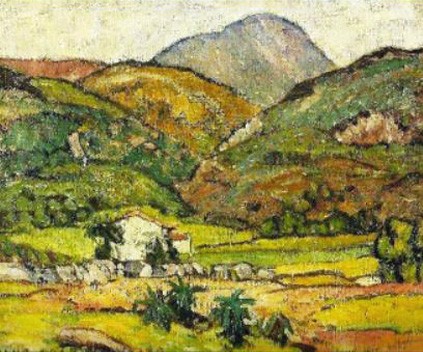
Goldthwaite returned to New York just before WWI and exhibited two paintings at the landmark 1913 Armory Show, which served as a shocking introduction to Modernism for American audiences. Anne lived most of her adult years in New York but spent summers with family in the South and was affiliated with the Dixie Art Colony in Wetumpka, Alabama. Her summers in and around Montgomery helped establish Goldthwaite as one of the South's most important regional artists of that era: she often depicted rural post-slavery scenes in oil paintings, watercolors, and etchings and completed two commissioned WPA murals on these subjects, "The Letter Box" in Atmore, Alabama (1938), and "The Road to Tuskegee" in Tuskegee, Alabama (1937). Goldthwaite was the only woman to receive two federal commissions for artwork in Alabama (Davis and Emerson 179).
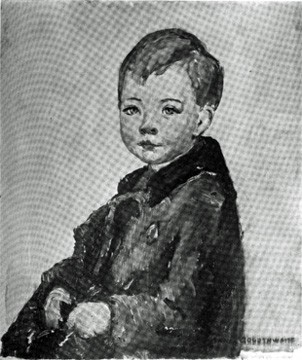
Goldthwaite's politics were progressive and she avidly supported women's suffrage, serving on the organizing committee for the 1915 Exhibition of Painting and Sculpture by Women Artists for the Benefit of the Women's Suffrage Campaign, open from September 27-October 18, 1915 at the Macbeth Gallery in New York. The organizing committee featured a number of other artists, including fellow Girls’ Art Club alumna Alice Morgan Wright, a sculptor who had lived at 4 rue de Chevreuse from about 1909-1912 (Dennison 2003, 24). Of the woman artists who exhibited their work at this benefit show, a remarkable number had been residents and/or exhibitors at the Club: Janet Scudder (3 sculptures), Elizabeth Edmond (sculpture), Anna Coleman Ladd (2 bronzes), Ethel Mars (2 woodblock prints), Alice Schille (painting, Constance Bigelow (painting), Matilda Brownell (painting), Lydia Field Emmet (2 paintings), Anne Goldthwaite (paintings and etchings), Mrs. M.J. McLane-Johansen (2 paintings), Grace Mott Johnson (2 bronzes), Kathleen McEnery (painting), Ethel P. Peets (née Canby, 2 etchings), Anne Estelle Rice (2 paintings), Olive Rush (painting), Maud Squire (2 pastel drawings), Mrs. L.M. Sterling (2 sculptures), Enid Yandell (2 bronzes), and Alice Morgan Wright (sculpture). Extensive details about the exhibition were published in The New York Times (“Art Sale to Aid Suffrage”).
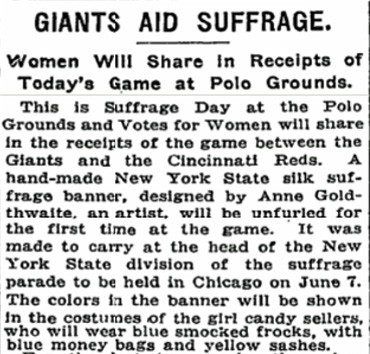
As the fight for women’s suffrage continued to ramp up, Goldthwaite designed a silk banner that was unfurled at a New York Giants baseball game at the historic Polo Grounds on June 3, 1916. On this so-called “Suffrage Day,” the Giants showed their support by sharing half of the proceeds from the day’s receipts with Votes for Women – this interesting show of solidarity was chronicled in The New York Times and other publications. Incidentally, though Goldthwaite designed the banner, it was Alice Morgan Wright who sewed it – the banner was also proudly carried during the massive suffrage parade in Chicago earlier in June 1916. One of their fellow suffragists was Helen Rogers Reid, daughter-in-law of Girls’ Art Club founder and benefactor, Elisabeth Mills Reid (“Woman Voters Speak”).
In 1915, Goldthwaite won a bronze medal for etching at the Panama-Pacific International Exposition in San Francisco and the McMillan Landscape Prize given by the National Association of Women Painters and Sculptors. She also celebrated a favorably-reviewed exhibition of her work at the Berlin Photographic Gallery on Madison Avenue in New York in October 1915. The show was praised by a critic for The Christian Science Monitor who declared, unironically, “[there is] not a single item that is altogether uninteresting” (“New York Art Galleries and Their Exhibits”). The New York Times published was even more effusive in its praise: “The work of Anne Goldthwaite would inspire a French critic to enthusiasm. It has those qualities in which the French delight, moderation and discretion, personal feeling held in close obedience to the law” (“A Modern Painter with a Strong Sense of Style”).
Over the course of her career as an artist, from approximately 1901 to 1942, Goldthwaite produced more than 300 etchings and lithographs (Ausfeld 1). As a painter, though she frequently depicted landscapes and rural scenes, Goldthwaite’s skill as a portraitist was universally acknowledged. An early review of her work by A.D. Defries in 1916 described the influence of Cezanne on her portraits and lauded her skills: “She works rapidly and what she gets is the vital impression of a mood or an appearance. …Beauty in quality of paint and in colour is another of Anne Goldthwaite’s values” (iv).
In addition to being recognized as an accomplished painter and printmaker, Anne enjoyed a successful career as an instructor (1922-1943) at the Art Students League of New York and served as President of the New York Society of Women Artists in 1937 and 1938. Near the end of her career as a teacher in 1943, Goldthwaite taught a talented young watercolorist named Stanley Kubrick, who would go on to become one of the most important film directors of the twentieth century (Davis and Emerson 23).
Though she died in New York in 1944, her funeral and burial took place in her beloved Montgomery, Alabama. In November 1944, the Knoedler Galleries in New York held a memorial retrospective exhibition of her career in which one of the featured canvases was none other than "4 rue de Chevreuse, Paris." Her work can be found today at such august institutions as the Metropolitan Museum of Art, the Art Institute of Chicago, the Baltimore Museum of Art, the Cleveland Museum of Art, the Rhode Island School of Design Museum, the Whitney Museum of American Art, and the Smithsonian American Art Museum.
Sources
- American Art Annual 1911, edited by Florence N. Levy. Vol. 9, New York: American Art Annual, Inc., 1911.
- “Art Sale to Aid Suffrage.” The New York Times, September 9, 1915, p.12.
- Ausfeld, Margaret Lynne. "Goldthwaite, Anne." Grove Art Online. June 02, 2011. Oxford University Press.
- Breeskin, Adelyn Dohme. Anne Goldthwaite: A Catalogue Raisonné of the Graphic Work. Montgomery, AL: Montgomery Museum of Fine Arts, 1982.
- Brummer, Joseph. Paintings and Etchings by Anne Goldthwaite, Exhibition Catalogue. New York: Brummer Gallery, Inc., 1921. Internet Archive.
- Catalogue of an Exhibition of Paintings, Watercolors and Etchings by Anne Goldthwaite, October 23-November 13, 1915. With an Introduction by Martin Birnbaum. New York: Berlin Photographic Company, 1915. Metropolitan Museum of Art Digital Collections.
- Davis, Anita Price and Jimmy S. Emerson. New Deal Art in Alabama: The Murals, Sculptures, and Other Works, and Their Creators. Jefferson, NC: McFarland & Company, 2015.
- Defries, A.D. “Anne Goldthwaite as a Portrait Painter.” The International Studio, vol. 59, no. 233, July 1916, pp. iii-vii.
- Dennison, Mariea Caudill. "The American Girls' Club in Paris: The Propriety and Imprudence of Art Students, 1890-1914." Woman's Art Journal, vol. 26, no. 1, Spring-Summer 2005, pp. 32-37. JSTOR.
- Dennison, Mariea Caudill: “Babies for Suffrage: The Exhibition of Painting and Sculpture by Women Artists for the Benefit of the Woman Suffrage Campaign,” Woman’s Art Journal, vol. 24, no. 2, Fall 2003, pp. 24–30. JSTOR.
- “Exhibition for Cause of Woman Suffrage.” The New York Times, September 26, 1915, p.SM21.
- “Giants Aid Suffrage.” The New York Times, June 3, 1916, p. 8.
- Goldthwaite, Anne Wilson. Unpublished Memoir. ca. 1910-1939. Archives of American Art, Anne Goldthwaite Papers, 1910-1950, Series 1, Box 1, Folder 1.
- M. Knoedler & Co. Memorial Exhibition, Anne Goldthwaite. New York: M. Knoedler, 1945.
- “A Modern Painter with a Strong Sense of Style.” The New York Times, October 24, 1915, p. SM21.
- New York Bureau of the Post-Dispatch. “Dance and Dress Here Freer Than in Paris.” St. Louis Post-Dispatch, August 26, 1913, p.3. ProQuest Historical Newspapers.
- Smith, M.D., Jeannette M. “Yellow Calla Lilies, Anne Goldthwaite.” JAMA, vol. 310, no. 17, November 6, 2013, pp.1774-1775.
- Special to The Christian Science from its Eastern Bureau. “New York Art Galleries and Their Exhibits.” The Christian Science Monitor, October 30, 1915, p. 21. ProQuest Historical Newspapers.
- “Woman Voters Speak.” The New York Times, May 28, 1916, p. 7.
![Anne Goldthwaite, “Gate at 3 rue de Chevreuse,” [incorrect address: should be 4 rue de Chevreuse], ca. 1907, etching on paper, Montgomery Museum of Fine Arts. Anne Goldthwaite, “Gate at 3 rue de Chevreuse,” [incorrect address: should be 4 rue de Chevreuse], ca. 1907, etching on paper, Montgomery Museum of Fine Arts.](/sites/default/files/styles/cu_crop/public/content/Goldthwaite%204%20rue%20de%20Chevreuse%20H504.png?h=25291e8a&itok=ATns70jA)
